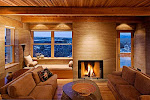This is fairly simple for a couple of reasons. I can't compose properly unless I can see something close to a final image in the field. If I don't use PC lenses I can't do this. Trying to compose a tight elegant composition when you have a drastically converging image is impossible for me. Also, it is important to utilize as much of the original file as possible. To get a first class product from these cameras is a stretch and you have to work very carefully to maximize resolution and sharpness etc. Perspective correction in Photoshop is first a form of cropping and second relies heavily on interpolation, both of which can compromise the quality of the final image and should be kept to a minimum.
The non T/S lens approach is a viable option for some people. As it stands now, the interpolation problems of radical perspective correction in PS (when working say with a prime 24) is about as messy as the full shift corner resolution softness of the Canon 24 T/S. BUT IMO (and really from my personal experience as an old 4x5 film convert to DSLR), working with primes and correcting perspective in PS means really you are shifting the composition phase of your creativity to the computer. I personally don't favor this approach. I like to see the image in the field, in the camera, where I can fine tune my composition and just do rather small corrections (like barrel distortion etc.) in PS. But as I said I made my living shooting architecture/interiors with a 4x5 view camera for 30+ years so I am used to making these decisions in the field. I simply cannot compose elegantly with a DSLR except in the field with T/S lenses.
Subscribe to:
Post Comments (Atom)













No comments:
Post a Comment